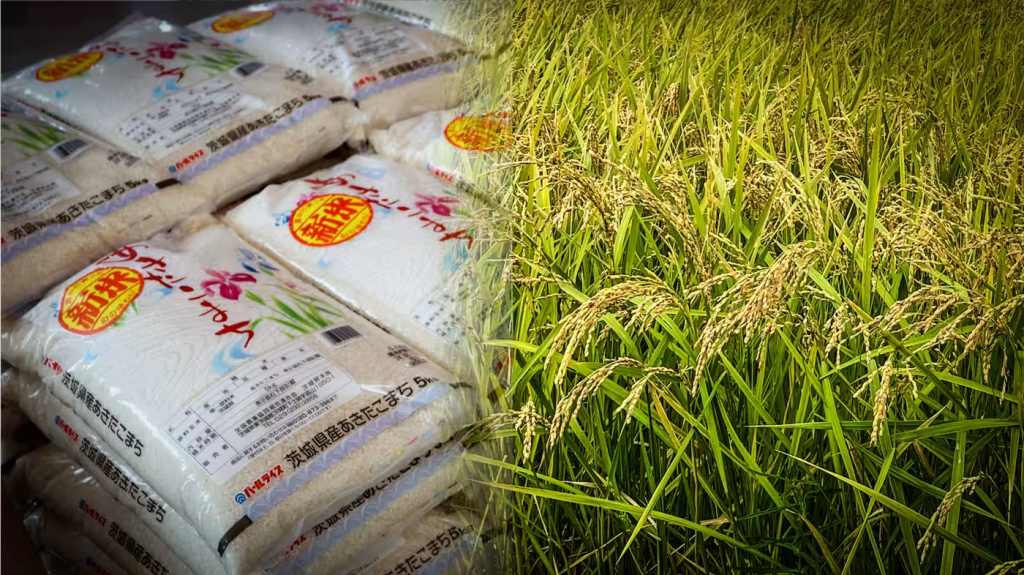Tags
Japan’s rice demand rises amid record tourist numbers
Heat wave and domestic demand also contribute to shortages and price hikes.

Nikkei staff writers
TOKYO — The demand for rice in Japan has increased for the first time in a decade, driven by a record number of tourists as well as strong domestic demand, leading to a shortage and purchase restrictions.
The rare growth in demand, along with a harvest hurt by a heat wave, caused bags of rice to disappear from some supermarkets. Distributors have moved to hike the price of Japan’s staple food.
Since 2014, domestic rice consumption has on average declined by about 100,000 tons every year as the population shrinks. But for the current year through June, domestic rice demand increased by 110,000 tons, or 1.6%, to 7.02 million tons.
The recent increase in demand is driven by several short-term factors, including record-breaking tourist numbers. Domestic demand has also been strong amid price increases for other staples. It was exacerbated in early August when a strong earthquake led to panic-buying.
The rice harvest last year was affected by the heat wave, affecting both the quality and quantity of the crop. This meant that more rice grains were needed for processing to produce a given amount of milled white rice.
Rice is one of the few staples fully supplied by Japanese farmers, with a self-sufficiency rate of nearly 100%. Production of the staple is guided by the government according to projected demand, for example by giving producers subsidies to switch to other products such as animal feed. Deviations from these estimates of demand and production, such as happened with the rise in tourism, can lead to shortages and price hikes.

According to data reported by Japan’s Ministry of Agriculture, Forestry, and Fisheries, the country’s private-sector rice inventory fell to 1.56 million tons in June, the lowest level since 1999 and 21% less than the previous year. The 2023 rice crop saw prices rise to 15,865 yen (about $110) per 60 kilograms, the highest in 11 years. Rice prices were up in July by 17% from the previous year, according to the official consumer price index (CPI).
The ministry estimates that inbound tourists might have accounted for 51,000 tons of the annual rice demand if they ate rice at two meals a day on average. The removal of COVID-19 restrictions and a weak yen have attracted a surge of tourists, who reached a new high of 21 million between January and July, significantly boosting demand for Japanese cuisine.
“It is true that inbound consumption is increasing,” said Youichi Uchikawa, deputy general manager of the sales department at a major rice wholesaler, Shinmei. Its affiliate Genki Sushi has seen a rise in inbound customers, leading to more rice being supplied to the chain, he said.
Some of Shinmei’s clients, including convenience stores, have also noticed an increase in popularity for rice balls among foreign visitors, Uchikawa added.
Food & Life Cos., operator of the largest conveyer-belt sushi chain, Sushiro, also told Nikkei Asia that the group’s rice procurement volume has been increasing. A company representative said this was due to a rise in the number of its stores, and that it does not specifically track inbound customer data.
Food & Life is trying to secure consistent supplies for customers by locking in medium- or long-term contracts with suppliers, the representative said.
On top of the tourism factor, domestic demand has been strong since last year, according to Shinmei’s Uchikawa. The wholesaler’s April sales of Japanese rice for household use were 10% higher than a year earlier, he said.
This was because rice prices remained relatively stable compared to other staples until the recent surge, Uchikawa said. Rice prices rose only 3.8% in 2023, while bread prices increased by 8.1% and noodles by 11.1%, according to CPI statistics.

Looking ahead, demand for rice will “all depend on how affordable the price will be” compared to other foods, said Uchikawa.
On the supply side, it was unusual last year that rice production was affected by a heat wave rather than cold weather, according to Yasuhiro Nakashima, a professor of agricultural economics at the University of Tokyo.
To adapt to the rising heat, rice developers in some regions are working on creating new varieties. “If these become more widely used, [rice supply] can be at least a little more stable,” Nakashima noted.
He added that changes in farming practices, such as water management techniques, will also be necessary to combat the effects of high temperatures.
Regarding the immediate outlook for supply and demand, the agriculture ministry anticipates the rice shortage will ease as more crops from this year enter the market this month.
A spokesperson for a major supermarket chain told Nikkei Asia that it expects to secure enough rice for its customers by the end of October, though prices are likely to remain high until then.
According to Shinmei’s Uchikawa, the northern regions of Tohoku and Hokkaido will begin shipping this year’s harvest by the end of September. “I believe [the prices] will stabilize a bit more” once the supply of new rice from all across Japan begins circulating, he said.
https://asia.nikkei.com/Business/Markets/Commodities/Japan-s-rice-demand-rises-amid-record-tourist-numbersPublished Date: September 6, 2024






